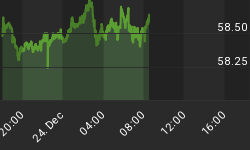The economies of the developed world are sluggish, unemployment is a real menace and debts are out of control (Figure 1). Nonetheless, the world's stock and commodity markets are defying all logic and advancing in the face of adverse economic conditions.
Today, many economists and strategists are scratching their heads in disbelief and they are struggling to explain the ongoing rally in risky assets. According to the bears, the stock market is in a clear bubble which is ready to pop!
In this issue of Money Matters, we will explain why risky assets are rising and the reasons why the uptrend could continue for several more months.
It is our contention that when it comes to the investment world, monetary policy trumps everything else and the risk free rate of return determines the prices of all assets. In order to be clear, the risk free rate of return refers to the yield available on the 10-US Treasury Note and it is this data point which has an enormous impact on asset prices.
It is no secret that lower interest rates encourage speculation, thereby creating higher prices for risky assets. Conversely, higher interest rates dampen speculation and cause risky assets to deflate. When the risk free rate of return is minimal, yield hungry investors are forced to be adventurous and they park their investment dollars in stocks and commodities. On the other hand, when the risk free rate of return is attractive, capital returns to cash and fixed income securities. Furthermore, in addition to the nominal risk free rate of return, investors also pay attention to the real risk free rate of return because this determines their future purchasing power.
Figure 1: Key Economic data
Source: Trading Economics
In the current economic environment, the Federal Reserve has pledged to keep the Fed Funds Rate at almost zero for at least another 3 years! Furthermore, the American central bank is now actively buying US Treasury securities across the entire yield curve. Thus, Mr. Bernanke is intentionally suppressing the nominal risk free rate of return and he is forcing investors to search for yield. By keeping interest rates artificially low and well below the rate of inflation, the Federal Reserve has engineered this impressive rally in American stocks.
Figure 2 captures the real US Treasury Yield Curve across various maturities. As you can see, the real yields of the entire US Treasury Yield Curve (except the 30-Year US Treasury Bond) are currently negative. Put simply, holders of all US Treasury securities (except those who own 30-Year US Treasury Bonds) are currently losing their purchasing power by lending money to the US government! Perhaps these bond holders expect deflation in the near future and maybe they will be proven right; but for now, their investment in US Treasuries is costing them money.
Figure 2: Real interest rates in the US
Source: www.thechartstore.com
Unfortunately, this confiscation of purchasing power is not just limited to the US. If you revisit Figure 1, you will note that in most nations, the inflation rate is higher than the interest rate. Thus, savers are being robbed throughout the developed world and out of sheer desperation, investment dollars are flowing towards stocks and commodities.
Despite all the talk of impending doom, the reality is that the world's stock markets are in well-established uptrends. Furthermore, 60-years of history suggests that a major bear market in the US may not arrive until the end of the next monetary tightening cycle.
Figure 3 shows the direct correlation between interest rate hikes and US recessions (grey shaded areas on the chart). As you will note, all US recessions over the past 60 years occurred after the Fed Funds Rate was pushed up by the Federal Reserve. More importantly, Figure 3 shows that none of the recessions occurred without preceding monetary tightening.
Figure 3: Fed Funds Rate and recessions
Source: St. Louis Fed
Today, the Fed Funds Rate is at almost zero and the Federal Reserve is on hold for at least another 3 years. Thus, unless it is different this time, history suggests that a recession is unlikely.
As investors, it is important to remember that throughout history, nasty bear markets have coincided with economic recessions. Therefore, if the US economy avoids slipping into a recession this year, it is conceivable that Wall Street may continue to advance over the following months. In our view, unless there is a serious credit event in Europe, the next major bear market will arrive towards the end of the next monetary tightening cycle. Until then, reasonable valuations, cheap money and investor scepticism should continue to create the right environment for a sustainable rally.
Whether you agree with it or not, the world's stock markets are inflating and the MSCI World Free Index has resumed its uptrend. Figure 4 confirms that the index has climbed above its 200-day moving average (light blue line) and the trend is up for now.
Figure 4: MSCI World Free Index
Source: www.fullermoney.com
As always, we do not know when this uptrend will end but given the favourable monetary environment, a sustainable advance cannot be ruled out. For sure, debt problems in Europe remain a legitimate threat and so does a spike in the price of oil. Nevertheless, given the fact that the US is in an election year and central banks are encouraging speculation, the odds favour the continuation of the uptrend.
For our part, we have allocated our equity portfolio to a variety of leading growth stocks which are increasing their earnings at a rapid pace. For our fund portfolio, we have invested capital in Asia, Latin America, China, India, precious metals, miners and energy. It is our belief that if Wall Street continues to advance, our holdings in these high-beta markets and sectors will perform well.















